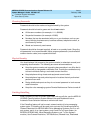
MERLIN LEGEND Communications System Release 6.0
System Manager’s Guide
555-660-118
Issue 1
February 1998
About Telecommunications
Page B-3Transmission Facilities
B
Identifying which telephone to ring (that is, supplying the identity of the called
party) was communicated verbally from the caller to the operator when human
operators handled call connections. After automatic switches were in place,
telephone numbers were assigned to telephone service subscribers. The caller
identified the called party to the switch by dialing the called party’s number. The
numbers were originally dialed by using a mechanical device called a
rotary dialer
with a spring that was wound up by turning it in one direction; on its return to
normal position, it created interruptions in the flow of current, generating dial
pulses recognized by the switch.
Although there are still some rotary-dial telephones in use today, most modern
telephones have touch-tone dialing that involves the creation of unique tones
produced by pressing buttons on the dialpad. Touch-tone dialing is faster and,
with the advent of services available from touch-tone phones, more versatile.
Today’s telephones still consist of the components described above. But, with
continued innovations, these basic elements have been enhanced to include
many other features and components, for example, built-in speakerphones,
programmable features and buttons, and even the capability to transmit and
receive digital signals.
Transmission Facilities 2
The telephone network can transmit various types of information which originates
in either of two forms:
analog
(continuously variable physical signals, for example,
speech or video signals) or
digital
(representation of signals in discrete elements
such as zero and one, for example, signals from computers). This information is
conveyed from one place to another in the network over communications paths
provided by transmission facilities. These facilities involve different types of media
as well as electronic equipment.
There are various types of media, including:
■ Open Wire. Strung on poles, uninsulated copper wire was used in the early
days of telecommunications until physical congestion became a problem. It
is still found, though rarely, in rural areas.
■ Paired Wire. Commonly called
twisted pair
. Consists of two copper wires,
individually insulated with wood pulp or plastic, twisted together.
■ Paired Cable. Combines many twisted pairs (from 6 to 3600) into a single
cable, originally sheathed in lead but now insulated with plastic. Cable can
be strung on poles, buried underground, or installed in a conduit of either
long blocks of concrete or plastic pipe. The first transoceanic underseas
cable was laid by AT&T in 1958.


















